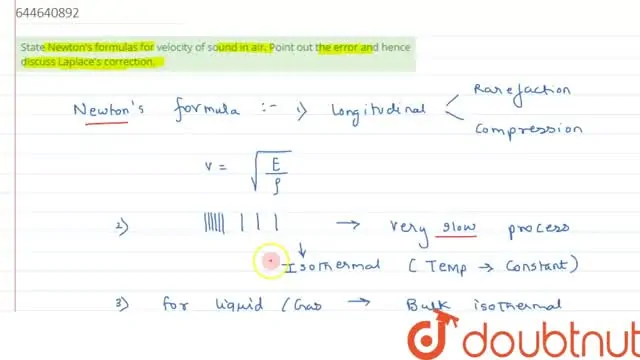Discuss Newton’s formula for velocity of sound in air medium and apply Laplace’s correction. Solution in Tamil
Newton's assumed that when sound propagates in ari, the formation of compression and rarefaction takes place in a very slow manner so that the process is isothermal in nature. It is found that, the heat produced during compression (pressure increases, volume decreases), and heat lost during rarefaction (Pressure decreases, volume increases) occure over a period of time such in a wavy that the temperature of the medium remains constant. Hene, by treating the air molecules to form an ideal gas, the changes in pressure and volume obey Boyle's law, Mathematically
PV=chonstant ..(1)
Differentiating equation (1) we get
PdV+VdP=0
(or) P−VdPdV=BT ...(2)
Where BT is an isothermal bulk modulus of air.
v=√Bρ ...(3)
Substituting equatio (2) in equation (3), the speed of sound in air is
vT=√BTρ=√Pρ
Since P is the pressure of air whose value at NTP (Norma Temperature and Pressure) is 76 cm of mercury, we have
P=(0.76×13.6×103×9.8)Nm−2
ρ=1.239kgm−3. Here ρ is density of ari. Then the speed of sound in air at normal temperature and pressure (NTP) is
vT=√(0.76×13.6×103×9.8)1.293
=270.80ms−1
=280ms−1 (theoretical value) But the speed of sound in air at 0∘C is experimentally observed as 332ms−1 that is close upto 16 % more than theoretical value.
Lapace correction : Laplace satisfactorily corrected this discrepancy by assuming that when the sound propagates through a medium, the particles oscillate very rapidly such that the compression and rarefaction occure very fast. Hene the exchange of heat produed due to compression and cooling effect due to rarefaction do not take place, because, air (medium) is a poor conductopr of heat. Since, temperature is no longer considered as a constant here, propagation of sound is an adiabatic process. By adiabatic considerations, the gas obeys Poisson's law (as Newton assumed), that is
PVγ=Constant ....(4)
where γ=CPCv, that is the ration between specific heat at constant pressure and specific heat at constant volume.
Differentiating equation (4) on both the sides, we get
VγdP+P(γVγ−1+dV)=0
Or , γP=−VdpdV=−BA ...(5)
where BA is the adiabatic bulk modulus of air.
v=√Bρ ...(6)
Now, substituting equation (5) in equation (6), the speed of sound in air is
vA=√BAρ=√γPρ
=√γvT
Since air contains mainly, nitrogen, oxygen, hydrogen etc. ( diatomic gas ) , we take γ=1.47. Hence, speed of sound in air is vA=(√1.4)(280ms−1=331.30ms−1 , which is very much closer to experimental data .
Related Playlists
- BOOK - PREMIERS PUBLISHERSCHAPTER - WAVESEXERCISE - EVALUTION TEXTBOOK QUESTIONS AND ANSWERS ( NUMERICAL PROBLEMS. )18videos
WAVES
- BOOK - PREMIERS PUBLISHERSCHAPTER - WAVESEXERCISE - EVALUTION TEXTBOOK QUESTIONS AND ANSWERS ( CONCEPTUAL QUESTIONS . )12videos
WAVES
- BOOK - PREMIERS PUBLISHERSCHAPTER - WAVESEXERCISE - EVALUTION TEXTBOOK QUESTIONS AND ANSWERS ( SHORT ANSWERS QUESTIONS : )30videos
WAVES
- BOOK - PREMIERS PUBLISHERSCHAPTER - QUESTION PAPER MARCH 2019EXERCISE - Part- IV23videos
QUESTION PAPER MARCH 2019
- BOOK - PREMIERS PUBLISHERSCHAPTER - WORK, ENERGY AND POWER EXERCISE - VERY SHORT ANSWER QUESTIONS34videos
WORK, ENERGY AND POWER
Similar Questions
The speed of a wave in a certain medium is 900 m/s. If 3000 waves passes over a certain point of the medium in 2 minutes, then compute its wavelength.
07:54View SolutionWhy is it that transverse waves cannot be produced in a gas? Can the transverse waves be produced in solids and liquids?
03:55View SolutionWhat is meant by waves?
05:25View SolutionThe force F acting on a body moving in a circular path depends on mass of the body (m) velocity(v) and radius (r) of the circular path. Obtain the expression for the force by dimensional analysis method (k=1)
05:37View SolutionWhen a work is said to be done? Give some example.
03:55View Solutionवायु में ध्वनि का वेग माध्यम के प्रत्यास्थता गुणांक तथा उसके घनत्व पर निर्भर करता है । विमीय विधि से ध्वनि के वेग का सूत्र स्थापित कीजिए ।
03:55View SolutionDescribe Newton's formula for velocity of sound waves in air.
03:55View SolutionComment on Laplace correction to Newton's formula for velocity of sound in air.
03:35View SolutionThe Laplace’s formula for sound waves is -
02:29View SolutionDescribe Newton's formula for velocity of sound waves in air.
03:21View SolutionDescribe Newton's formula for velocity of sound waves in air.
01:46View SolutionDescribe Newton's formula for velocity of sound waves in air.
05:14View SolutionDiscuss the dependence of velocity of sound on temperature and density of a medium.
01:46View SolutionDiscuss the effect of temperature and density on the velocity of sound in air.
01:55View SolutionThe error in the value of velocity of sound in air by Newton’s formula and as determined by experiment at 0^@C is
01:45View Solution


